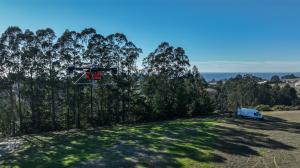Office of Naval Research Awards Parallel Flight Technologies $3.74M Contract to Develop Maritime-Capable Firefly UAS
Parallel Flight advances Firefly UAS into a cost-effective, purpose-built platform, adapting its exceptional specs with heavy fuel for maritime naval operations
This contract validates our hybrid powertrain architecture and demonstrates enthusiasm for Firefly as a next-generation UAS platform”
LA SELVA BEACH, CA, UNITED STATES, September 9, 2025 /EINPresswire.com/ -- Parallel Flight Technologies (PFT), a leader in heavy-lift, hybrid-powered unmanned aerial systems (UAS), has been awarded a $3.74 million Sequential Phase II SBIR contract to modify its flagship aircraft, Firefly, for maritime operations. The contract, funded by the Office of Naval Research (ONR), marks a significant milestone in expanding the UAS’s mission versatility for deployment in harsh marine environments to support maritime logistics, littoral surveillance, and ONR RDT&E activities.— Craig Stevens, CEO
Under the contract, the maritime Firefly will be modified to operate from naval vessels with features such as heavy fuel (JP-5) compatibility, advanced deck-landing sensors, saltwater corrosion protection, flotation devices, deck-locking mechanisms, and expanded Beyond Visual Line of Sight (BVLOS) testing.
Parallel Flight’s NDAA-compliant Firefly is produced in the USA and widely regarded as a “heavy-lift workhorse.” A two-person-portable quadcopter that fits in the back of a pickup truck, Firefly is optimized for expeditionary defense and industrial missions. Its patented Parallel Hybrid Electric Multirotor (PHEM) propulsion system enables payloads up to 100 lb (45 kg) and endurance 10x greater than all-electric UAS, while also supplying 2 kW of continuous in-flight power to payloads. The platform is protected by five patents and supported by DIU, USDA, NASA, and NSF.
“This award is a powerful vote of confidence in the technology we’re building at Parallel Flight,” said Craig Stevens, CEO of Parallel Flight Technologies. “It validates our hybrid powertrain architecture and demonstrates enthusiasm for Firefly as a next-generation UAS platform. The maritime Firefly is just the beginning—this dual-use technology will not only expand critical military capabilities, but also unlock a wide range of public and commercial opportunities, from logistics and disaster response to environmental monitoring and precision agriculture.”
The maritime-capable Firefly will support advanced naval missions—including mine countermeasures, underwater vehicle detection, and hydrographic surveys—addressing a critical capability gap with a cost-effective, domestically produced, long-range VTOL solution. Commercial applications are also on the horizon. Firefly’s extended endurance, VTOL design, and heavy payload capacity position it as a high-impact solution for offshore logistics, medical delivery, island resupply, and more.
“This contract is not just about building a better drone,” Stevens added. “It’s about exploring the full potential of our parallel hybrid electric propulsion technology to increase the utility of unmanned systems for the military and industry, alike.”
Sarah Abdi
Parallel Flight Technologies
email us here
Visit us on social media:
LinkedIn
Instagram
Facebook
YouTube
Legal Disclaimer:
EIN Presswire provides this news content "as is" without warranty of any kind. We do not accept any responsibility or liability for the accuracy, content, images, videos, licenses, completeness, legality, or reliability of the information contained in this article. If you have any complaints or copyright issues related to this article, kindly contact the author above.

